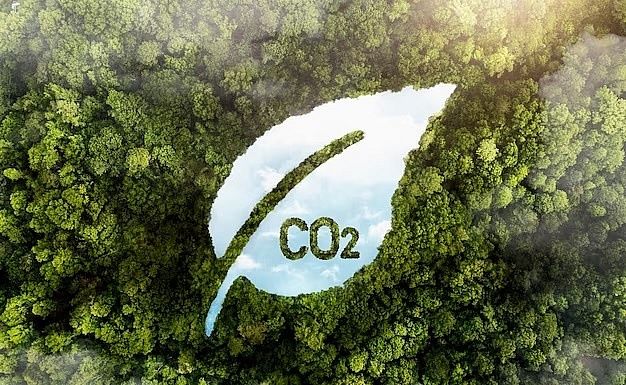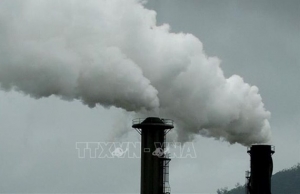Vietnamese carbon market yet to achieve lift off
At the end of September, Vietnam launched its first carbon credit trading floor. Hoang Bach Duong, vice president of CT Group said, “We hope to inspire firms to switch to cleaner, lower-carbon, and more efficient technology.”
In the new competition in the global supply chain, meeting the carbon tax barrier standards that major markets are employing will play a decisive role.
 |
| Vietnamese carbon market yet to achieve lift off, illustration photo/ Source: freepik.com |
Since October 1, the EU has begun testing a carbon tax on products exported to the market under the Carbon Border Adjustment Mechanism. In 2024, the United States will be the next to implement such a mechanism, which will impose a carbon tariff on importers.
Carbon certificates are becoming an instrument for improving global competitiveness as the green financial market develops. According to MarketsandMarkets, the global market for carbon credit trading platforms could reach $317 million by 2027, a rise from $106 million in 2022.
Asia-Pacific is anticipated to grow the quickest between now and 2028, followed by Europe. Since announcing in 2021 that it would reach net-zero emissions by 2050, Vietnam has attracted the attention of numerous carbon credit traders from around the globe.
Pham Thu Thuy, director of the Centre for International Forestry Research and World Agroforestry (CIFOR-ICRAF) said, “Several foreign buyers want to purchase carbon credits from Vietnam, but they still have legal issues that are not near to being solved.”
The recognition and issuance of carbon credits in Vietnam are still dependent on third parties such as organisations and international credit mechanisms, and Vietnam’s role as a seller remains unclear, even though developing the carbon credit market is one of tools of the 2020 Law on Environmental Protection.
According to Thuy, carbon credit purchasers require assistance from the government’s organising agency.
“Vietnam does not have a carbon rights registry or a list of carbon-related companies and initiatives, making it challenging for buyers to save time and seek costs,” Thuy said.
In Peru and Brazil, purchasers have easy access to data from exchanges displaying credit prices and excess or deficiency of carbon credits in each sector, including forestry, energy, and cattle.
The carbon market is based on the operational principles of a competitive market, which are beneficial for both buyers and sellers. According to Vu Tan Phuong, director of the Vietnam Forest Certification Office, Vietnam has a policy foundation but lacks explicit guidance on which activities qualify as carbon emissions or carbon absorption.
“Vietnam still lacks a carbon tax, and transactions are primarily voluntary via projects and initiatives. The lack of policy instruments will make it extremely hard to establish a carbon market,” Phuong said.
To pursue a development path that incorporates resilience and net-zero emissions, the World Bank estimates that Vietnam will need to invest an additional $368 billion through 2040, or 6.8 per cent of its GDP annually.
Particularly, the voyage towards reducing emissions while also meeting international commitments accounts for about 30 per cent of resource requirements.
However, the Vietnamese public sector will only be able to provide approximately one-third of the required resources. As the green finance market is still in its infancy, the resources mobilised through the green finance market are minimal in comparison to requirements.
The opening of the carbon market in Vietnam faces significant financial obstacles, too. Thomas Jacobs, country director for Vietnam, Cambodia, and Laos at the International Finance Corporation (IFC), said private capital is the key to Vietnam’s green transition.
In September, the IFC pledged to invest approximately $150 million in local currency sustainability-linked bonds issued by BIM Group subsidiaries BIM Land JSC ($100 million) and Thanh Xuan JSC ($50 million).
According to Jacobs, the sustainable bond link assists the two companies in conserving water and enhancing energy efficiency at three hotels that will satisfy EDGE standards, IFC’s green building certification.
These solutions are anticipated to reduce annual CO2 emissions by approximately 4,000 tonnes. According to the IFC, the issuance of sustainability-linked bonds in local currency by two BIM Group subsidiaries is the first in Vietnam.
In a setting where companies are under pressure to go green to maintain competitiveness and investors favour sustainable development initiatives, Doan Quoc Huy, CEO of BIM Group, said that IFC’s financing and consulting will facilitate the green transition process while increasing the product’s appeal. “We expect to draw in foreign capital as we develop a green and high-quality tourism infrastructure,” he said.
According to Nguyen Van Minh, a representative from the Department of Climate Change under the Ministry of Natural Resources and Environment (MoNRE), when Vietnam completes the carbon market development roadmap, current problems will be resolved.
The MoNRE will coordinate with the Ministry of Finance towards 2027 to design regulations and pilot the operation of the greenhouse gas emission quota and carbon credit trading platform before its official operation in 2028. Carbon credits and emission quotas will be available on the trading platform.
The MoNRE will work closely with relevant stakeholders in the future to assign emission quotas to each enterprise in accordance with Decision No.01/2022/QD-TTg. “If emissions exceed the prescribed level, businesses will be required to purchase additional quotas from other businesses or the state, with a 10 per cent cap. This is to prevent large businesses from spending a lot of money to buy carbon credits to offset their emissions,” Minh said.
| The carbon market was first mentioned in Decision No.1775/QD-TTg in 2012, which approved the greenhouse gas (GHG) emissions management project on managing carbon credit commercial activities for the global market. In January 2022, the government issued Decree No.06/2022/ND-CP regulating the reduction of GHG emissions and the preservation of the ozone layer. |
 | Vietnam makes efforts to develop domestic carbon market In the context that about 70 countries and territories have applied carbon pricing instruments, experts held that Vietnam should also apply such tools, especially by developing the domestic carbon market, in order to support the realisation of the country’s greenhouse gas (GHG) emissions reduction target. |
 | Vietnam poised to become large-scale carbon credit market The Emissions Reduction Purchase Agreements (ERPAs) for 11 forests in the south central region and Central Highlands will lay the foundation for Vietnam's large-scale carbon credit market. |
 | Gryphon Canada enters Vietnamese market After expanding its business operations in Vancouver, Taichung, Beijing, Shanghai, and Hong Kong, Gryphon Canada, an art-focused real estate developer hailing from Vancouver, has come to Vietnam. VIR's Bich Ngoc spoke with Jason Hsu, founder and CEO of Gryphon Canada, about his journey to bring the company's real estate products to the Vietnamese market. |
What the stars mean:
★ Poor ★ ★ Promising ★★★ Good ★★★★ Very good ★★★★★ Exceptional
Related Contents
Latest News
More News
- Heavy industries set for pilot greenhouse gas quotas (December 25, 2025 | 10:00)
- Swedfund invests in MSME growth and climate action in Vietnam (December 19, 2025 | 11:42)
- GreenYellow brings solar energy to light up remote schools in Tuyen Quang province (December 19, 2025 | 08:00)
- Charge+, Grab partner to develop EV charging network in Vietnam (December 18, 2025 | 17:11)
- Linking sci-tech and innovation to Vietnam’s net-zero future (December 18, 2025 | 14:31)
- Driving double-digit growth through green and circular transformation in Vietnam (December 17, 2025 | 09:00)
- Standard Chartered and ACCA deepen collaboration to develop Vietnam’s talent for a sustainable future (December 15, 2025 | 18:18)
- Schaeffler reports strong early output from Dong Nai solar project (December 12, 2025 | 15:16)
- Forestry conference highlights biodiversity and sustainability goals (December 09, 2025 | 13:35)
- Home Credit honoured among top 10 sustainable companies in trade and services (December 09, 2025 | 12:18)

 Tag:
Tag:




















 Mobile Version
Mobile Version